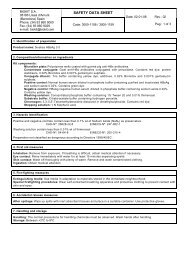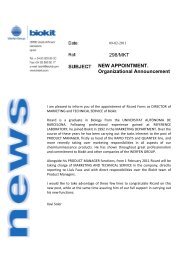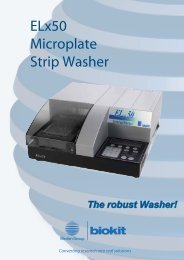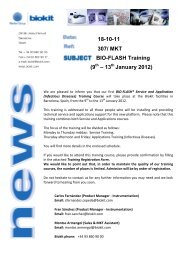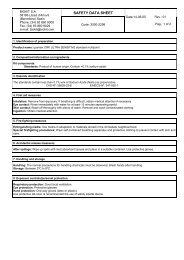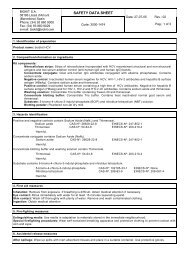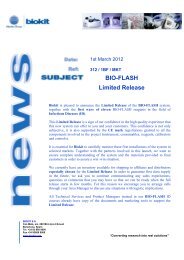Bioelisa HTLV I+II 5.0 Product improvement - Biokit
Bioelisa HTLV I+II 5.0 Product improvement - Biokit
Bioelisa HTLV I+II 5.0 Product improvement - Biokit
You also want an ePaper? Increase the reach of your titles
YUMPU automatically turns print PDFs into web optimized ePapers that Google loves.
ioelisabioelisa <strong>HTLV</strong>-<strong>I+II</strong> <strong>5.0</strong>READ HIGHLIGHTED CHANGES3000-1165 192 testsELISA test for the detection of antibodies to <strong>HTLV</strong>-I and <strong>HTLV</strong>-II in human serum or plasma. It is intendedas a screening test, requiring repeat testing of initially reactive samples.SummaryHuman T-cell Lymphotropic Viruses (<strong>HTLV</strong>s) are pathogenic retroviruses that may cause severe haematologicaland neurological diseases in infected individuals. The <strong>HTLV</strong> family comprises of two well-studied members:<strong>HTLV</strong>-I and <strong>HTLV</strong>-II, as well as two newly discovered members: <strong>HTLV</strong>-3 and <strong>HTLV</strong>-4. <strong>HTLV</strong>-I is known as theetiological agent of adult T-cell leukemia / lymphoma (ATL), <strong>HTLV</strong>-associated myelopathy / tropical spasticparaparesis (HAM/TSP), and <strong>HTLV</strong>-associated uveitis. <strong>HTLV</strong>-II infection has also been associated with leukemiaand neurological disease although it is less pathogenic than <strong>HTLV</strong>-I. Several lines of molecular evidencessuggest that <strong>HTLV</strong>-3 possesses some of the <strong>HTLV</strong>-I properties although little is known about the pathogenicityof <strong>HTLV</strong>-3.Studies of the geographic distribution of <strong>HTLV</strong>-I infection reveal that the virus is highly prevalent in Japan, Africa,Caribbean islands and South America. Recent epidemiological studies in the United States and Europe confirm thepresence of a mixed prevalence of both <strong>HTLV</strong>-I and <strong>HTLV</strong>-II among different high-risk populations, such asintravenous drug users and transfusion recipients. The viruses can be transmitted through sexual contact, andthrough contaminated blood products, and mother to child via breast-feeding.The bioelisa <strong>HTLV</strong>-<strong>I+II</strong> <strong>5.0</strong> is a direct sandwich immunoassay that utilises a combination of recombinantproteins and a tri-fusion recombinant protein labeled with horseradish peroxidase. This test format assuressimultaneous detection of various specific IgA, IgG and IgM antibodies against <strong>HTLV</strong>-I and <strong>HTLV</strong>-II. In addition,external tests had shown bioelisa <strong>HTLV</strong>-<strong>I+II</strong> <strong>5.0</strong> is capable of detecting antibodies to <strong>HTLV</strong>-3/STLV-3(see specific Performance Chapter).The bioelisa <strong>HTLV</strong>-<strong>I+II</strong> <strong>5.0</strong> is intended as a semi-quantitative enzyme-linked immunosorbent assay for thedetection of antibodies to both <strong>HTLV</strong>-I and <strong>HTLV</strong>-II found in human serum or plasma. It is intended as a first linescreen, requiring repeat testing of initially reactive specimens and confirmation of repeat reactive specimens bysupplemental assays.PrincipleThe wells of the polystyrene microplate strips are coated with a mixture of three different <strong>HTLV</strong> recombinantproteins, which correspond to the highly antigenic segments of <strong>HTLV</strong>-I and <strong>HTLV</strong>-II viruses. The conjugate isbased on a tri-fusion recombinant protein, which is labeled with horseradish peroxidase. The tri-fusion antigen isgenerated by cloning of three cDNA fragments coding for the three <strong>HTLV</strong> recombinant proteins into a single vector.Human serum or plasma, diluted in the diluent containing the conjugate, is incubated in a coated well. <strong>HTLV</strong>-I/IIspecific antibodies (IgA, IgG and IgM), if present, will bind to both the antigens immobilised on the solid phase andthe tri-fusion antigen of the conjugate. After incubation, the wells are thoroughly washed to remove unboundmaterials. A colorless substrate solution containing chromogen 3,3’, 5,5’ - tetramethylbenzidine (TMB) is thenadded to each well. The presence of specific antibodies is indicated by the presence of a blue colour afterincubation, which changes to yellow when the color reaction is terminated by the addition of sulphuric acid. Theintensity of the resulting yellow product is measured at 450nm using a spectrophotometer and is proportional to theamount of antibodies present in the sample.Components1. MCPL MICROPLATE:2 Plates of twelve 8-well strips. Each well contains adsorbed <strong>HTLV</strong>-I and-<strong>HTLV</strong>-II recombinant proteins. Storeat 2-8°C.2. CONTROL – NEGATIVE CONTROL:1 x 1.8 ml of normal human serum, non reactive for anti-HCV, anti-HIV-1/2, anti-<strong>HTLV</strong>-I/II and HBsAg.Contains thimerosal and sodium azide as preservatives. Store at 2-8°C.3. CONTROL + POSITIVE CONTROL:1 x 1.8 ml of inactivated human serum containing a high titre of IgG antibodies specific for <strong>HTLV</strong>-I/II and nonreactive for anti-HCV, anti-HIV-1/2 and HBsAg. Contains thimerosal and sodium azide as preservative.Store at 2-8°C.BIOKIT, S.A. - 08186 Lliçà d’Amunt - Barcelona - SPAIN08433000-1165 R02 03.2010 eng.doc



